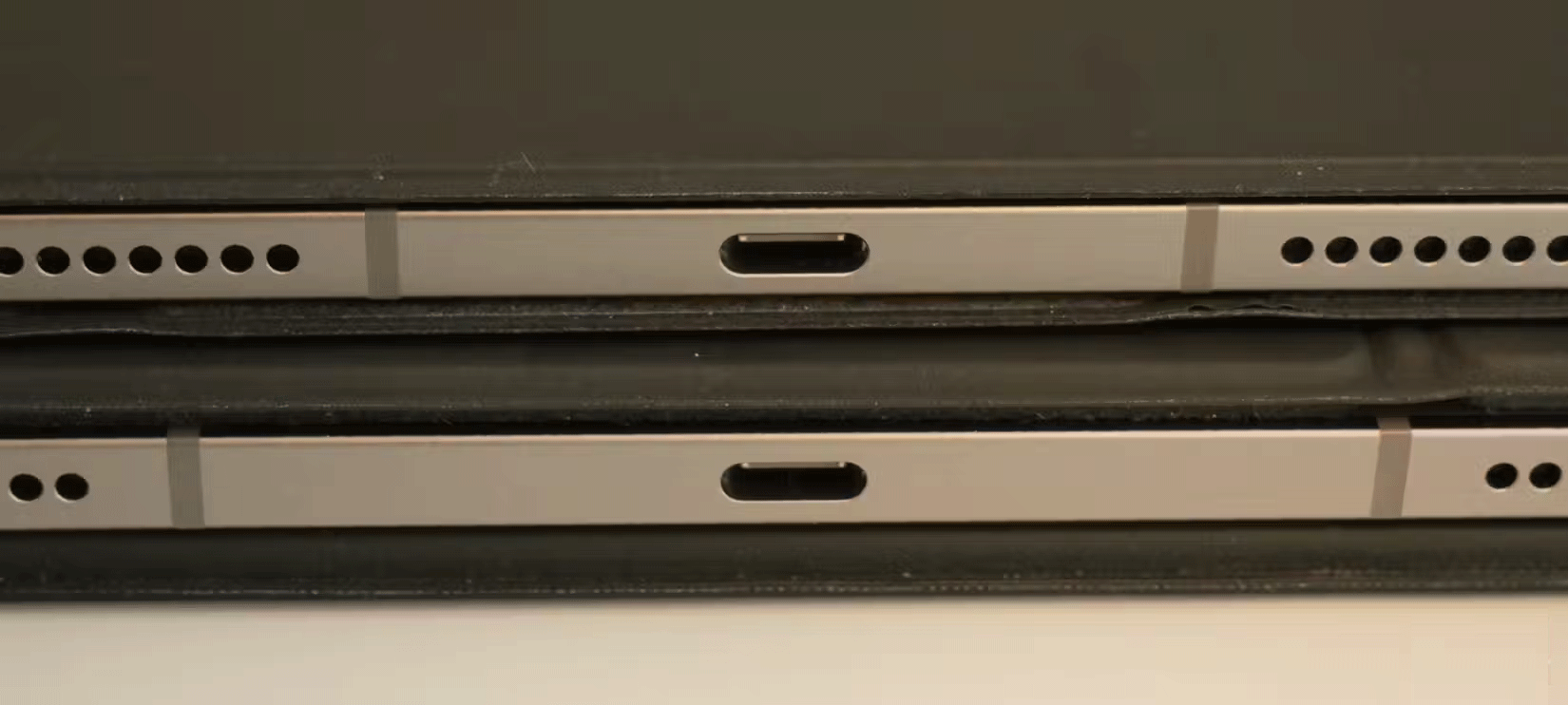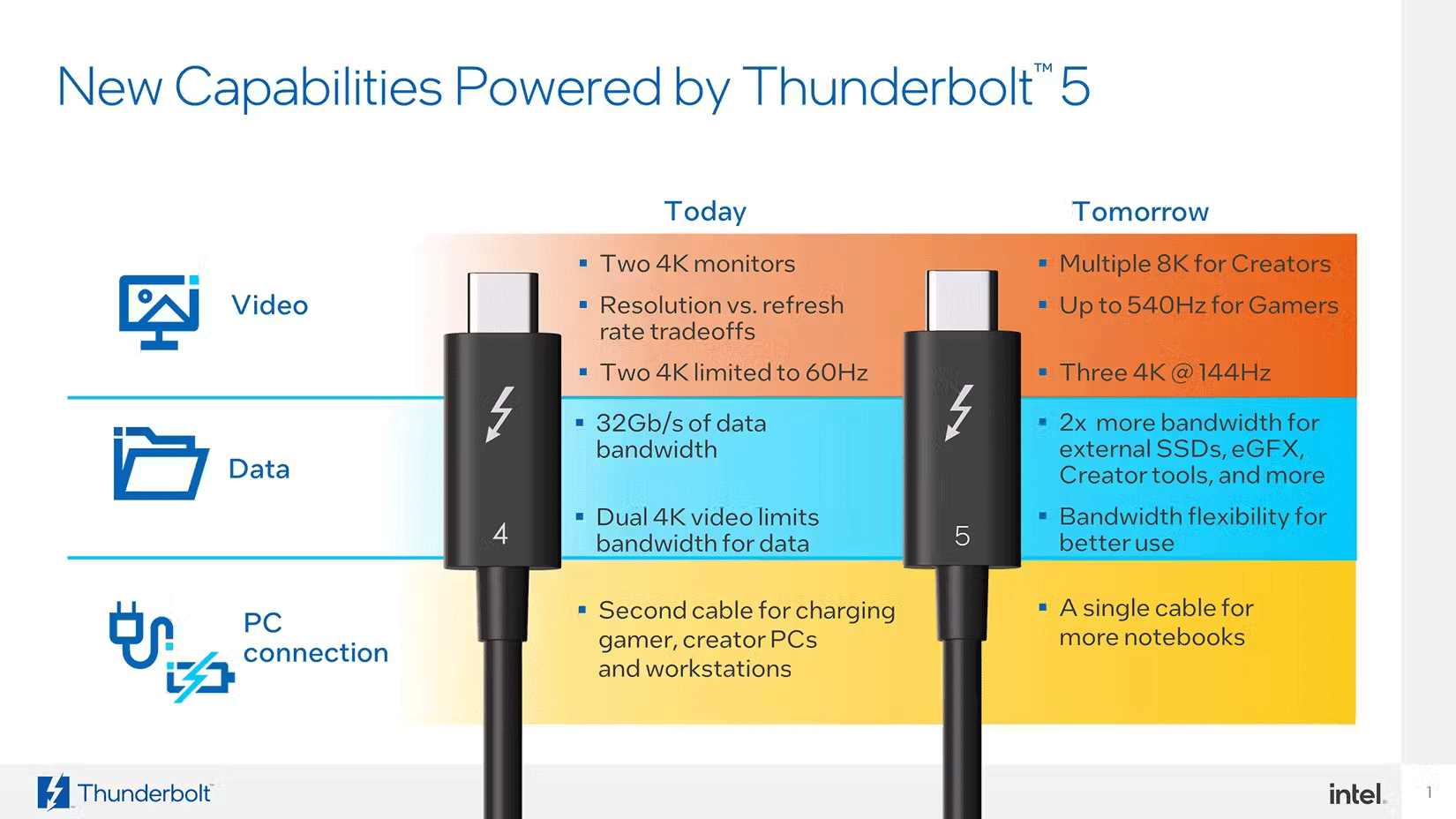How does Thunderbolt actually work?
However, everything you need to know about Thunderbolt ports is easier to understand when broken down into simple, concise sections.
What is a Thunderbolt port?
Thunderbolt is a high-speed communications interface developed by Intel. First introduced in 2011, Thunderbolt technology combines multiple functions into a single port: it can transfer data, transmit video and audio signals, and even power devices. This makes it popular for connecting external displays, high-speed storage drives, and docking stations.
One of the standout features of Thunderbolt is the use of the USB-C connector from version 3 onwards. This means the same port can handle everything from high-definition video to fast file transfers, while also supporting daisy-chaining multiple devices, perfect for KVM switches and docking stations.
Are Thunderbolt and USB-C the same?
When looking for USB, there are two things to consider: Interface and protocol. Interface refers to the physical shape of the USB port and connectors, while protocol describes the features and capabilities of the USB connection.

While the latest versions of Thunderbolt use the same USB-C connector, they are not the same as USB-C. USB-C refers to the interface or physical shape of the port and cable, while Thunderbolt is the protocol that uses the interface to provide more advanced features.
In addition to Thunderbolt, other protocols can be used with USB-C, such as DisplayPort (DP), which provides connectivity to support 16K video; Power Delivery (PD), which allows for up to 240W of power, and standard USB protocols, such as USB 3 and USB 4.
The great thing about the Thunderbolt USB-C port is that it essentially combines the features of DisplayPort, Power Delivery, and the latest USB standard, plus features that are unique to Thunderbolt. This simplifies things, as a single Thunderbolt logo on a device already indicates support for some level of DP, PD, and high-bandwidth data transfer. Thunderbolt ports are essentially USB-C ports with the latest features. They offer faster data transfer speeds, better video performance, and additional features like serial, which USB-C can't do on its own.
The Difference Between Thunderbolt 3, 4, and 5
Now that you know that USB-C is a version of the USB interface, what about Thunderbolt? Are there different versions of this protocol?

At the time of writing, most Thunderbolt devices use either the Thunderbolt 3 or 4 protocol. Thunderbolt 5 is also on the way, and is expected to be widely available by mid-2025. Thunderbolt 5 was released in 2023, but the first Thunderbolt 5s were available in mid-2024. You can identify which version of Thunderbolt a device or connector supports by the number indicated near the Thunderbolt logo. However, some devices may not indicate a version number. You'll have to look at the supplied spec sheet or search online.
Each new version of Thunderbolt improves speed, video capabilities, and security. Let's break down the key differences between Thunderbolt 3, 4, and the upcoming Thunderbolt 5.
| Features | Thunderbolt 3 (2015) | Thunderbolt 4 (2020) | Thunderbolt 5 (2024) |
|---|---|---|---|
| Maximum speed | 40 Gbps | 40 Gbps | 80 Gbps (bi-directional), up to 120 Gbps in special cases (unidirectional) |
| Video support | Dual 4K or single 5K display | Dual 4K or single 8K display | Supports higher resolution displays, up to 3 4K displays or 2 8K displays |
| PCIe data transfer | 16 Gbps | 32 Gbps | 64 Gbps |
| Power Delivery | Up to 100W | Up to 100W | Up to 240W |
| Daisy-Chaining (Peer-to-Peer Connection) | Yes, up to 6 devices | Yes, up to 6 devices | Yes, up to 6 devices for better performance |
| Security | Basic | Add DMA protection | PCIe tunneling |
While Thunderbolt 4 didn't offer a speed boost over Thunderbolt 3, it did improve security, reliability, and video capabilities. However, Thunderbolt 5 promises a huge jump in performance, especially in bandwidth for video and graphics-intensive tasks.
You should read it
- Compare USB4 and Thunderbolt 4
- The reason Thunderbolt 3 is the preferred connection standard
- Why Apple's Thunderbolt 4 Pro Cable Is So Expensive, $129
- Detecting a Thunderbolt flaw allows a hacker to steal system data for 5 minutes
- The Mac may support both USB 3.0 and Thunderbolt
- CT scan of Apple's Thunderbolt 4 Pro cable shows why it costs $129
- Who is ThunderBolt for?
- Ultrabook supports Thunderbolt shipped in the second quarter
May be interested
- Standard 10Gb connection per second from Apple and Intel
 the thunderbolt connector on the new macbook pro can exchange data in a dual channel with speeds of up to 10 gbps per second.
the thunderbolt connector on the new macbook pro can exchange data in a dual channel with speeds of up to 10 gbps per second. - Apple LED Cinema Display is equipped with Thunderbolt
 the new apple led cinema display maintains the traditional design but is equipped with an additional high-speed thunderbolt connector.
the new apple led cinema display maintains the traditional design but is equipped with an additional high-speed thunderbolt connector. - Share files between 2 computers using Target Disk Mode
 target disk mode allows you to share files between 2 mac computers together with firewire, thunderbolt 2, usb-c, or thunderbolt 3 (usb-c) ports. this feature is extremely useful when you need to transfer data at a fast rate or if you want to display the files you receive from the computer does not work.
target disk mode allows you to share files between 2 mac computers together with firewire, thunderbolt 2, usb-c, or thunderbolt 3 (usb-c) ports. this feature is extremely useful when you need to transfer data at a fast rate or if you want to display the files you receive from the computer does not work. - The new Macbook Air will be available in June
 parts suppliers for apple in taiwan said they have begun shipping new macbook air products using sandy bridge and thunderbolt chips since the end of may.
parts suppliers for apple in taiwan said they have begun shipping new macbook air products using sandy bridge and thunderbolt chips since the end of may. - Microsoft explains why the Surface does not have Thunderbolt and cannot upgrade RAM
 this is also a problem that many surface users have been wondering for a long time, and the new answer given by microsoft is due to security issues of this connection protocol.
this is also a problem that many surface users have been wondering for a long time, and the new answer given by microsoft is due to security issues of this connection protocol. - Compare speed of connection standards
 your computer (including desktop and laptop) has many different types of connectors. these connections could be usb 2.0, usb 3.0, esata, thunderbolt, firewire and ethernet ...
your computer (including desktop and laptop) has many different types of connectors. these connections could be usb 2.0, usb 3.0, esata, thunderbolt, firewire and ethernet ... - Microsoft fixes that blue image on Windows 10 when connecting an NVMe SSD
 this issue affects windows 10 devices with at least one thunderbolt nvme ssd port and one thunderbolt port.
this issue affects windows 10 devices with at least one thunderbolt nvme ssd port and one thunderbolt port. - Apple updates firmware for MacBook Pro, Mac mini
 apple has released firmware updates for the latest mac mini and macbook pro models to solve problems with lion internet recovery and thunderbolt connectivity.
apple has released firmware updates for the latest mac mini and macbook pro models to solve problems with lion internet recovery and thunderbolt connectivity. - 5 effective ways to help you work smarter
 not to work hard to be effective, it is important to know how to work smartly.
not to work hard to be effective, it is important to know how to work smartly. - How to find meaning in work and work happily?
 perfect work always makes you feel satisfied and meaningful is probably quite a bit of a mess. so how to find meaning in work and work happily? let's tipsmake.com find out!
perfect work always makes you feel satisfied and meaningful is probably quite a bit of a mess. so how to find meaning in work and work happily? let's tipsmake.com find out!










 How to View Recalled Messages on Messenger on PC, Android, iOS
How to View Recalled Messages on Messenger on PC, Android, iOS Learn About Motion: The AI-Powered Task Manager
Learn About Motion: The AI-Powered Task Manager iPhone 16 Details
iPhone 16 Details 5 most reputable websites to make money by viewing ads
5 most reputable websites to make money by viewing ads How to Find Friends Nearby on Facebook for iPhone, Android
How to Find Friends Nearby on Facebook for iPhone, Android How to download TikTok videos without watermark on computer using x2convert
How to download TikTok videos without watermark on computer using x2convert